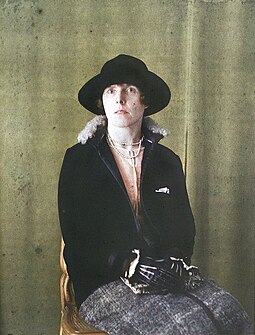
Summary
Geertruida Luberta de Haas-Lorentz (20 November 1885 – 1973) was a Dutch physicist and professor of the Technical University of Delft. She was the first to theoretically study thermal fluctuations in electric circuit, treating electrons as Brownian particles. Consequently she is considered one of the pioneers of electrical noise theory. She was the daughter and doctoral student of Hendrik Lorentz.
Geertruida Luberta de Haas-Lorentz | |
|---|---|
 De Haas-Lorentz in 1927 | |
| Born | Geertruida Luberta Lorentz 20 November 1885 Leiden, Netherlands |
| Died | 1973 (aged 87–88) Leiden, Netherlands |
| Alma mater | University of Leiden |
| Known for | first to perform fluctuational analysis of electrons as Brownian particles |
| Spouse | Wander Johannes de Haas |
| Children | 4 |
| Parents |
|
| Scientific career | |
| Fields | Physics |
| Institutions | Technical University of Delft |
| Thesis | Over de theorie van de Brown'schen beweging en daarmede verwante verschijnselen (1912) |
| Doctoral advisor | Hendrik Lorentz |
Life edit
Berta Lorentz was born in Leiden, Netherlands, the eldest daughter of the physicist and 1902 Nobel Prize in Physics winner Hendrik Lorentz and Aletta Catharina Kaiser. At that time her father was Professor of Theoretical Physics at the University of Leiden.[1]
On 22 December 1910, she married Wander Johannes de Haas, who would become professor of experimental physics in Leiden, and they went on to have two sons and two daughters.
She studied physics at the University of Leiden with her father as dissertation advisor[2] and earned her doctor's degree in 1912 on a thesis entitled "On the theory of Brownian motion and related phenomena" (Dutch: Over de theorie van de Brown'schen beweging en daarmede verwante verschijnselen).[3]
After defending her doctoral dissertation in Leiden, de Haas-Lorentz taught physics at the Technical University of Delft and translated some of her father's works into German.[1] She also wrote a biography of her father.[4]
Berta de Haas-Lorentz died in 1973 in Leiden.
Research edit
De Haas-Lorentz was one the first to apply Albert Einstein's theory of Brownian motion to other domains.[5] During her thesis work, she was the first to carry out a theoretical analysis of thermal fluctuation of electrons in electrical circuits, predating the experimental discovery of the Johnson–Nyquist noise.[6] She considered that a circuit with resistance R and inductance L should store an energy E = LI2/2, where I is the current. If there was a fluctuating thermal current, by the equipartition theorem the energy would be related to the thermal energy kT where k is the Boltzmann constant and T is the temperature. De Haas-Lorentz obtained,
- ,
where the angle brackets denote the thermal average.[7]
She was also the first to propose thermal fluctuations limit the detection of electromagnetic radiation.[5]
In collaboration with her husband, the de Haas couple showed that experiments carried by James Clerk Maxwell failed to prove the hypothesis of André-Marie Ampère, that magnetism in matter is caused by microscopic current loops.[8][9]
She also predicted the London penetration depth for superconductivity in 1925, before the development of the London equations in 1935.[10][11]
References edit
- ^ a b Parkadze V., Women Physicists, p. 71-75, Tbilisi, 1988.
- ^ Haas-Lorentz, Geertruida. "Math Genealogy Project". Retrieved 2020-10-24.
- ^ Geertruida de Haas-Lorentz (1912). "Over de theorie van de Brown'sche beweging en daarmede verwante verschijnselen" (PDF).
- ^ Haas-Lorentz, Geertruida Luberta de (1957). H.A. Lorentz: Impressions of His Life and Work. North-Holland Publishing Company.
- ^ a b Van Der Ziel, A. (1980-01-01), Marton, L.; Marton, C. (eds.), "History of Noise Research", Advances in Electronics and Electron Physics, vol. 50, Academic Press, pp. 351–409, retrieved 2024-03-16
- ^ Dörfel, G. (2012-08-15). "The early history of thermal noise: The long way to paradigm change". Annalen der Physik. 524 (8): 117–121. doi:10.1002/andp.201200736. ISSN 0003-3804.
- ^ Yeang, Chen-Pang (2024-01-30). Transforming Noise: A History of Its Science and Technology from Disturbing Sounds to Informational Errors, 1900-1955. Oxford University Press. ISBN 978-0-19-888776-8.
- ^ Haas, W. J.; Haas-Lorentz, G.L. (1917). "An experiment of Maxwell and Ampere molecular currents" (PDF). KNAW, Proceedings. 19 (I). Amsterdam: 248–255.
- ^ San Miguel, Alfonso; Pallandre, Bernard (13 March 2024). "Revisiting the Einstein-de Haas experiment: the Ampère Museum's hidden treasure" (PDF). Europhysics News: 12–14.
- ^ Fossheim, Kristian, and Asle Sudbø. Superconductivity: physics and applications. John Wiley & Sons, 2005.
- ^ de Haas-Lorentz, G. L. (1925). "Iets over het mechanisme van inductieverschijnselen". Physica (in Dutch). 5: 384–388.
External links edit
- Ph.D. students of H.A. Lorentz: 1881-1921
- Photo of De Haas-Lorentz
- Geertruida de Haas-Lorentz at the Mathematics Genealogy Project
- Dissertation of De Haas-Lorentz


